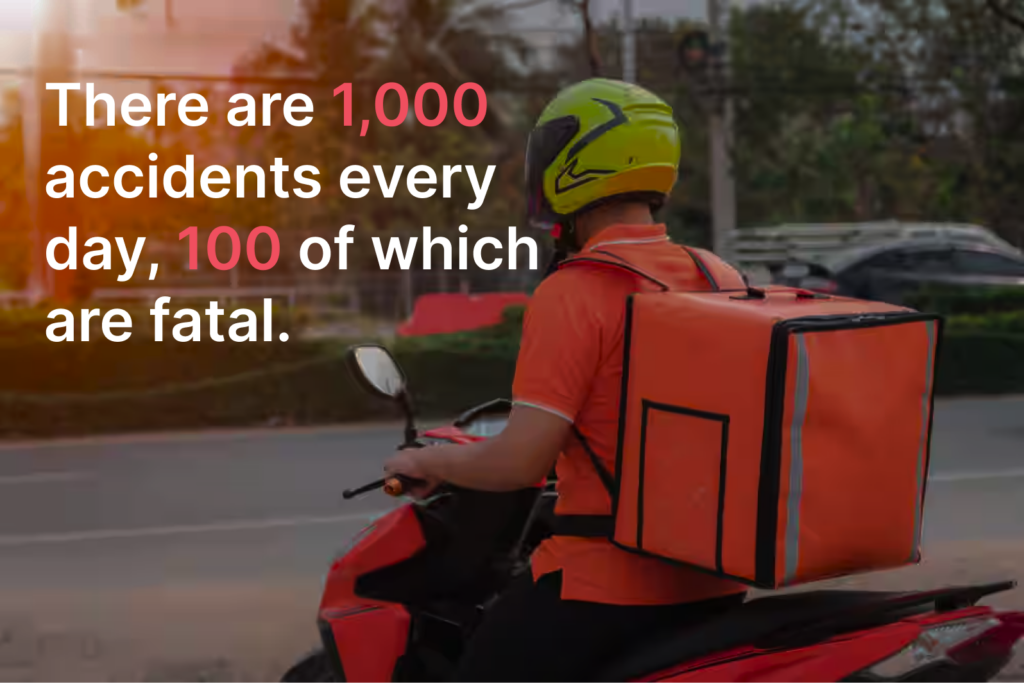A moment we all know
Picture this: a delivery driver arrives at your door with your hot meal or groceries, a moment many of us experience regularly. Incredibly, over the past year, moments like these have occurred nearly 50 billion times. That's 158 deliveries every second, every day, all year long.
And this isn’t slowing down. By 2027, the annual number of deliveries is projected to double to 100 billion, with nearly a quarter of the global population relying on food and grocery delivery services.
Hidden risks behind the convenience
This growing demand for convenience comes at a high cost. Two-wheeler delivery drivers, who make this possible, face significant daily risks. According to Sentiance data, there is one accident for every 143,000 orders—a staggering 350,000 accidents annually, or nearly 1,000 every day.

Worse yet, around 10-15% of these accidents result in fatalities, equating to approximately 35,000 lives lost each year, or 100 fatalities daily.
Why are delivery drivers at such high risk?
Several factors contribute to this alarming trend:
- Inexperience: In many countries, drivers can obtain licenses quickly with minimal training.
- Time Pressure: Drivers are pushed to meet tight delivery deadlines, leading to speeding.
- Fatigue: Long shifts and inadequate rest take a toll on concentration and reaction times.
- Distractions: Navigating apps while driving increases the risk of accidents.
- Low Wages: Insufficient pay forces drivers to work longer hours or take more risks to meet earning targets, compromising their safety.
According to the U.S. Bureau of Labor Statistics, delivery drivers account for nearly 20% of occupational fatalities. They are 1.8 times more likely to die on the job than police officers. And how crazy is this? The very people bringing us the convenience we crave are facing life-threatening risks every single day—risks higher than those faced by individuals in professions we traditionally associate with danger. It’s a sobering reality that demands our attention and action.
A glimpse of hope
Some regions and companies are taking steps toward change. For instance, Transport for London (TfL) introduced a Safety Charter in 2023, outlining 10 road safety principles to protect riders and pedestrians.
Also, companies like our client Talabat, have adopted in-app telematics-based safety programs. Riders are scored based on their driving behavior and coached toward safer habits. In less than a year, Talabat reduced accident rates by an impressive 56%.
If such initiatives were adopted globally and we applied this 56% reduction to the current incident rates, up to 18,000 lives could be saved annually—enough to fill a football stadium!
The industry's resistance to change
Despite the success of safety programs, widespread adoption remains slow due to challenges such as:
- Gig Economy Dynamics: Platforms fear that safety programs using monitoring technologies could redefine the employer-employee relationship, increasing liability and taxes.
- Profit vs. Safety: Some features contributing to safety (e.g., reducing trip counts or shift durations) are seen as potentially limiting profits, despite being highly coachable and impactful.
A call to action: Toward a regulated safety score
To truly protect delivery drivers, the industry must embrace a unified approach, such as a regulated Safety Score—similar to food hygiene ratings in restaurants. This would ensure:
- Accountability for safety practices.
- Incentives for safer driving behavior.
- Alignment with global initiatives like Vision Zero, which aims to eliminate traffic fatalities by 2050.
Building a safer future
With advancements in technology and the collective will to act, we can create a world where convenience no longer comes at the cost of human lives. By implementing scalable, cost-effective safety measures, we can continue to enjoy the convenience of food and grocery deliveries while ensuring the safety and well-being of the heroes who make it possible.
We’re driving this change through innovative, data-driven safety solutions for ride-hailing and delivery platforms. Our on-device technology empowers companies to protect their drivers while improving operational efficiency.
Download our free driver safety for ride-hail and delivery platforms eBook, and discover actionable strategies to safeguard delivery drivers and transform safety in the on-demand economy.


